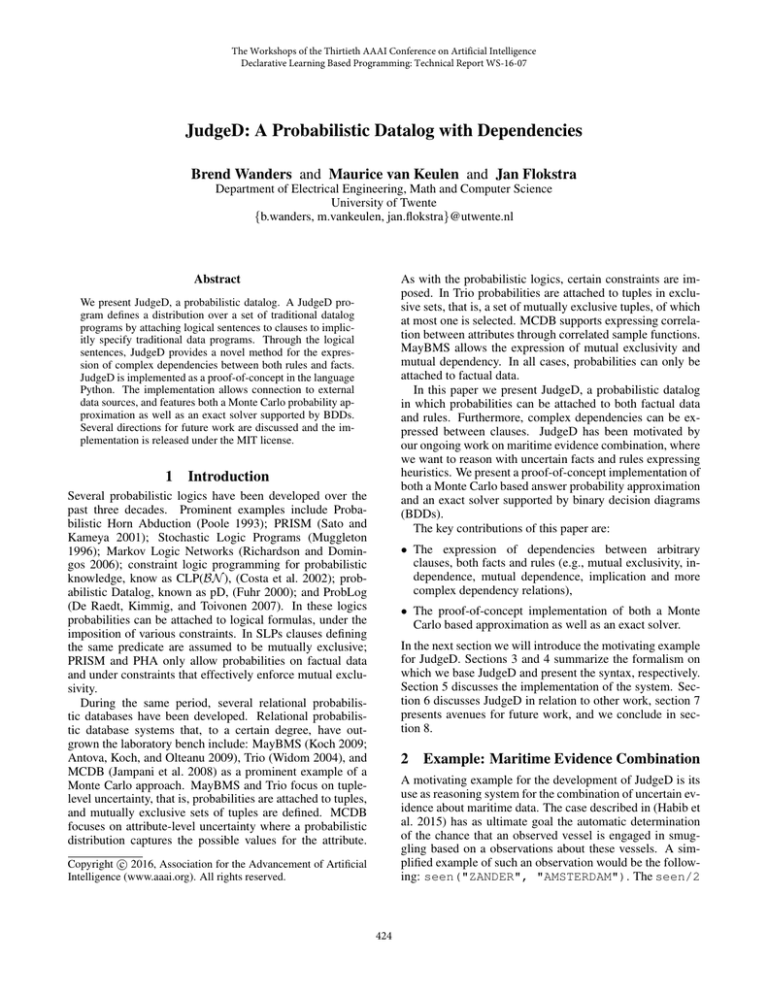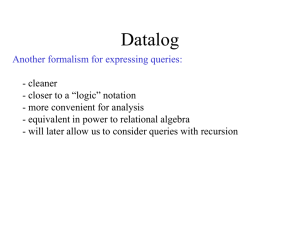
The Workshops of the Thirtieth AAAI Conference on Artificial Intelligence
Declarative Learning Based Programming: Technical Report WS-16-07
JudgeD: A Probabilistic Datalog with Dependencies
Brend Wanders and Maurice van Keulen and Jan Flokstra
Department of Electrical Engineering, Math and Computer Science
University of Twente
{b.wanders, m.vankeulen, jan.flokstra}@utwente.nl
Abstract
As with the probabilistic logics, certain constraints are imposed. In Trio probabilities are attached to tuples in exclusive sets, that is, a set of mutually exclusive tuples, of which
at most one is selected. MCDB supports expressing correlation between attributes through correlated sample functions.
MayBMS allows the expression of mutual exclusivity and
mutual dependency. In all cases, probabilities can only be
attached to factual data.
In this paper we present JudgeD, a probabilistic datalog
in which probabilities can be attached to both factual data
and rules. Furthermore, complex dependencies can be expressed between clauses. JudgeD has been motivated by
our ongoing work on maritime evidence combination, where
we want to reason with uncertain facts and rules expressing
heuristics. We present a proof-of-concept implementation of
both a Monte Carlo based answer probability approximation
and an exact solver supported by binary decision diagrams
(BDDs).
The key contributions of this paper are:
We present JudgeD, a probabilistic datalog. A JudgeD program defines a distribution over a set of traditional datalog
programs by attaching logical sentences to clauses to implicitly specify traditional data programs. Through the logical
sentences, JudgeD provides a novel method for the expression of complex dependencies between both rules and facts.
JudgeD is implemented as a proof-of-concept in the language
Python. The implementation allows connection to external
data sources, and features both a Monte Carlo probability approximation as well as an exact solver supported by BDDs.
Several directions for future work are discussed and the implementation is released under the MIT license.
1
Introduction
Several probabilistic logics have been developed over the
past three decades. Prominent examples include Probabilistic Horn Abduction (Poole 1993); PRISM (Sato and
Kameya 2001); Stochastic Logic Programs (Muggleton
1996); Markov Logic Networks (Richardson and Domingos 2006); constraint logic programming for probabilistic
knowledge, know as CLP(BN ), (Costa et al. 2002); probabilistic Datalog, known as pD, (Fuhr 2000); and ProbLog
(De Raedt, Kimmig, and Toivonen 2007). In these logics
probabilities can be attached to logical formulas, under the
imposition of various constraints. In SLPs clauses defining
the same predicate are assumed to be mutually exclusive;
PRISM and PHA only allow probabilities on factual data
and under constraints that effectively enforce mutual exclusivity.
During the same period, several relational probabilistic databases have been developed. Relational probabilistic database systems that, to a certain degree, have outgrown the laboratory bench include: MayBMS (Koch 2009;
Antova, Koch, and Olteanu 2009), Trio (Widom 2004), and
MCDB (Jampani et al. 2008) as a prominent example of a
Monte Carlo approach. MayBMS and Trio focus on tuplelevel uncertainty, that is, probabilities are attached to tuples,
and mutually exclusive sets of tuples are defined. MCDB
focuses on attribute-level uncertainty where a probabilistic
distribution captures the possible values for the attribute.
• The expression of dependencies between arbitrary
clauses, both facts and rules (e.g., mutual exclusivity, independence, mutual dependence, implication and more
complex dependency relations),
• The proof-of-concept implementation of both a Monte
Carlo based approximation as well as an exact solver.
In the next section we will introduce the motivating example
for JudgeD. Sections 3 and 4 summarize the formalism on
which we base JudgeD and present the syntax, respectively.
Section 5 discusses the implementation of the system. Section 6 discusses JudgeD in relation to other work, section 7
presents avenues for future work, and we conclude in section 8.
2
Example: Maritime Evidence Combination
A motivating example for the development of JudgeD is its
use as reasoning system for the combination of uncertain evidence about maritime data. The case described in (Habib et
al. 2015) has as ultimate goal the automatic determination
of the chance that an observed vessel is engaged in smuggling based on a observations about these vessels. A simplified example of such an observation would be the following: seen("ZANDER", "AMSTERDAM"). The seen/2
c 2016, Association for the Advancement of Artificial
Copyright Intelligence (www.aaai.org). All rights reserved.
424
predicate expresses that a vessel, ZANDER, is seen in a port,
AMSTERDAM.
Reasoning about the observations is supported by a
knowledge base of vessels and their attributes. The knowledge base consists of factual knowledge about the vessels expressed through vessel/1, vessel name/2 and
vessel imo/2 predicates. A sample fishing vessel called
ZANDER and identified with IMO number 7712767 (the International Maritime Organization number is a unique identifier for the vessel) is described as:
again, this can be expressed by the rule: smuggling(V)
:- caught smuggling(V). By attaching a probability
to this rule, it becomes a heuristic for determining if a vessel
is engaged in smuggling.
Dependencies between rules are necessary to express such
heuristics with disjunctions in them: if there is a 0.45 chance
that ship is smuggling if it is “blue or has an unreadable
name” — a purely fictitious heuristic — this is expressed
in datalog through two separate rules smuggling(V)
:- vessel blue(V)
and
smuggling(V) :vessel name unreadable(V), and these two rules
need to be in or out together.
vessel(v0).
vessel_name(v0, "ZANDER").
vessel_imo(v0, 7712767).
vessel_type(v0, stern_trawler).
3
Additional attributes in the knowledge base are described as
additional predicates matching the vessel ???/2 pattern.
The goal is to answer the query smuggling(V)? with
a set of vessels, each associated with the probability that,
given the observations, they are engaged in smuggling.
Formal Basis
The semantics of JudgeD programs are similar to those of
ProbLog, in that JudgeD programs specify multiple traditional datalog programs. In this section we try to give an intuitive understanding of JudgeD semantics, a more in-depth
discussion of the formal underpinnings of JudgeD can be
found in (Wanders and van Keulen 2015).
A JudgeD program J specifies a multitude of traditional
datalog programs, albeit in a more compact representation.
Let WJ be the set of all traditional datalog programs specified by the JudgeD program. Each partitioning ω n divides
W into n covering disjoint partitions. Each program is labeled with a label ω=v, with ω the partitioning, and v the
partition into which the program is placed. This way, every
program in W has a set of associated labels, with exactly one
label from each partitioning. In other words, labels from the
same partitioning are mutually exclusive, and exactly one of
them is true for any given datalog program. For example,
given partitionings x2 and y 2 we can construct all datalog
programs in W by enumerating: {x=1, y=1}, {x=1, y=2},
{x=2, y=1}, and {x=2, y=2}.
A JudgeD program consists of a set of clauses. In JudgeD
every clause ci has an attached propositional sentence ϕi
called a descriptive sentence. We use the shorthand hci , ϕi i
to denote that sentence ϕi is attached to clause ci . The descriptive sentence uses partitioning labels, of the form ω=v,
as atoms to A describe the set of traditional datalog programs for which the datalog clause holds: the clause is part
of every datalog program for which ϕi evaluates to true
given that the labels attached to the datalog program are the
only labels that are true. For example, the clause hA, x=2i
is fully defined as follows:
Uncertain facts Facts, both observations and vessel information in the knowledge base, can be uncertain. An example of an uncertain observation is the interpretation of
a verbally reported observation: uncertainty about the observed vessel is easily possible due to a low-quality radio communication. The two interpretations of the spoken report are: seen("ZANDER", "AMSTERDAM") and
seen("XANDER", "AMSTERDAM"). These two observations are mutually exclusive with each other.
Another example would be uncertainty about two observations. For example, if a harbourmaster receives two reports from different sources about a ship sighted of the coast,
there can be doubt about whether these are two ships, or if
this is one vessel sighted twice. When he receives a radioed
report about a sighting of the vessel XANDER and at the same
time gets a report about the just sighted ZANDER, there are
three different ways to report the situation:
report(r1, "XANDER").
He makes a single report stating that the vessel XANDER was
sighted, assuming that the second sighting was actually the
same ship, but with an unclearly pronounced name.
report(r1, "ZANDER").
He makes a single report stating that the ZANDER was
sighted, confident that the other report was simply a report
for the same ship.
report(r1, "XANDER").
report(r2, "ZANDER").
x=2
Ah ← A1 , A2 , . . . , Ai
This clause has the normal semantics that Ah holds if
A1 through Ai hold, and only in those datalog programs
for which the descriptive sentence x=2 holds. Using the
previous example partitionings, this clause is part of two
datalog programs specified with the following sets labels:
{x=2, y=1} and {x=2, y=2}.
Alternatively, the harbourmaster can make two reports. If
both names were heard correctly, there are two ships of the
coast. In this situation, there is uncertainty about what facts
are true.
Uncertain rules Probabilities attached to rules can be interpreted as a form of heuristic. By stating that a rule
does not always hold, any answers derived through that
rule will take the probability that the rule holds into account. For example, if domain expertise holds that any vessel caught smuggling is likely to be engaged in smuggling
Dependencies between clauses The dependencies between clauses can be expressed with descriptive sentences
logically combining different labels. Mutual dependency
can be expressed by using the same sentence for the clauses.
425
5
For example ha, ϕi and hb, ϕi describe the situation where
the clauses a and b always hold in the same datalog programs. Implication can be expressed by containment. For
example ha, ϕi and hb, ϕ ∧ ψi describes the situation that
whenever a is in a datalog program, then b is too. Mutual exclusivity can be expressed through mutually exclusive sentences. For example, ha, ϕi and hb, ψi are mutually
exclusive if ϕ ∧ ψ ≡ false.
The proof-of-concept implementation of JudgeD is based on
SLG resolution for negative Prolog as described in (Chen,
Swift, and Warren 1995). The focus of the implementation is
not on raw performance, but on ease of prototyping, as such
the system is implemented in Python1 to allow for quick prototyping of new approaches.
The implementation is structured such that a basic implementation of Datalog with negation was created first. The
basic implementation also allows the introduction of native
predicates, i.e., predicates that are implemented in Python.
Native predicates can be used to pull data from external data
sources, such as a relational database or a graph database,
into the query answering process.
The basic implementation was then used as a basis for
two methods of evaluation: a Monte Carlo approximation,
and an exact solver.
Probability calculation One can attach a probability
n
P (ω=v
Pn) to each partition v of a partitioning ω provided
that v =1 P (ω=v ) = 1. As is known from the U-relations
model (Antova et al. 2008) and variations thereof such
as (van Keulen 2012), calculating probabilities of possible
worlds or the existence of an assertion among the worlds,
can make use of certain properties that also apply here. For
example P (ω1 =v1 ∧ ω2 =v2 ) = P (ω1 =v1 ) × P (ω2 =v2 )
and P (ω1 =v1 ∨ ω2 =v2 ) = P (ω1 =v1 ) + P (ω2 =v2 ) iff
ω1 6= ω2 .
Given a JudgeD program J and a query q, the naive approach to calculate the probability of the query answer is
to enumerate all possible datalog programs P ∈ WJ , and
sum the probabilities of each program P for which there is
a proof for q. This quickly becomes infeasible for any nontrivial amount of uncertainty.
4
Implementation
Monte Carlo Approximation
Monte Carlo approximation for a query q boils down to repeated weighted sampling of a traditional datalog program
Pi from all implicitly specified datalog programs WJ in the
JudgeD program J, and evaluating q for each sampled Pi .
Sample weights are calculated by simple multiplication of
the probabilities attached to the labels associated with P .
Instead of determining the weights of each datalog program, a lazy-evaluation scheme is used to construct a set
of sampled labels only from those partitionings that are encountered during the search for a proof. This scheme allows
the evaluation of q over knowledge bases with enormous
amounts of uncertainty, as long as that uncertainty is ‘local’.
That is, if the uncertainty is expressed as large numbers of
partitionings, each with a moderate number of labels.
The implementation features a rudimentary stopping criterion by determining the root mean square error of the samples observed up till now, and if the error moves below a
configurable threshold the approximation is terminated.
The Monte Carlo approximation allows the use of the full
expressiveness of negative Datalog, with the lazy-evaluation
scheme allowing the application to knowledge bases with
large amounts of uncertainty. Furthermore, because of the
non-intrusive nature of the scheme, it can easily be applied
to other types of solvers. A disadvantage of the Monte Carlo
solver is that it will not provide the logical sentence that describes for which datalog programs the proof holds. It will
only provide the probability of the answer.
Probabilistic Datalog
The syntax of JudgeD program closely resembles traditional
datalog, with the addition of the descriptive sentences. Additionally, the probabilities attached to the labels are included
in the syntax. An example of a simple coin-flip would be:
heads(c1) [x=1].
tails(c1) [x=2].
@P(x=1) = 0.5. @P(x=2) = 0.5.
The first two lines establish simple facts and attach sentences
to make them mutually exclusive. The third line contain annotations that attach probabilities to the labels to allow the
calculation of answer probabilities. When presented with
the query heads(C)? the answer heads(c1) has a probability of 0.5.
To show how dependencies can be expressed in practice
recall the example of uncertain facts on page 2: the example describes two sightings of vessels called XANDER and
ZANDER, with doubt about whether they are the same vessel. The harbourmaster has three options: report one vessel
named XANDER (n=1), report one vessel named ZANDER
(n=2), or report them both as separate vessels (s=2). In
JudgeD this can be expressed as follows:
report(r1, "XANDER") [ s=1 and n=1 ].
report(r1, "ZANDER") [(s=1 and n=2) or s=2].
report(r2, "XANDER") [s=2].
Exact Solver
In contrast with the Monte Carlo solver, the Exact solver
determines the exact sentence ϕa describing in which datalog programs the proof for the answer a was found. This is
done based on the knowledge that for any answer the resolution proof can be restricted to a linear sequence of clauses
c1 , c2 , . . . , ci , with attached sentences ϕ1 , ϕ2 , . . . , ϕi . The
By creating a partitioning s2 we effectively describe a choice
between datalog programs: one where the two reports refer
to the same vessel, and another where the two reports refer to
different vessel. The choice of selecting the name XANDER
or ZANDER, represented by the partitioning n2 , is dependent upon s=1, as expressed by the conjunction. Complex
dependencies can be expressed by combining the and, or
and not operations.
1
426
https://www.python.org
sentence for the answer follows from the needed clauses as:
ϕa =
i
^
a
ϕn
b
n=1
If the sentence ϕa is consistent, then answer a can be proven
in all datalog programs for which the sentence holds. An
inconsistent sentence shows that there are no datalog programs contained within the JudgeD program for which there
is a valid proof.
Efficient construction of this sentence is done by constructing partial sentences during SLG resolution, i.e., unification, of two clauses G and C. The partial sentence ϕA for
the resolvent A is equal to the conjunction of the sentences
associated with G and C: ϕA = ϕG ∧ ϕC . If this sentence
is inconsistent this means that G and C are not unifiable because there is no datalog program for which this proof will
hold.
If a new fact is discovered during the search it is only
necessary to expand on it if it is not subsumed by an already
discovered fact. While datalog has no functions, and thus
no functional subsumption, the introduction of descriptive
sentences creates a different kind of subsumption. A new
fact hf, ϕi is subsumed by an already known fact ha, ψi if
ϕ ∧ ψ ≡ ψ. If this is the case, the new fact does not add
new knowledge to the already expanded knowledge base,
because any proof that leads to the new fact comes from
already explored datalog programs.
The efficient detection of sentence subsumption is done
through the use of Binary Decision Diagrams (Bryant 1992).
A binary decision diagram is a graphical representation of
a boolean function over a number of variables. Given a
complete ordering over the variables a Reduced Ordered Binary Decision Diagram, more commonly known simply as
a BDD, provides a canonical representation of the boolean
function. A BDD can be constructed by starting with a binary decision tree in which all non-leaf nodes represent variables and all leaf nodes represent either 1 or 0. Non-leaf
nodes have a ‘high’ and a ‘low’ child. Each path from the
root to a leaf represents a full assignment of truth values to
each variable, with variables encountered in the order determine by the full ordering. A BDD can be constructed from
this tree by merging isomorphic subgraphs and reducing redundant nodes until no further reduction is possible. An example of a BDD for the function f = (a ∧ b) ∨ c can be seen
in figure 1.
The current exact implementation is restricted to positive
datalog, and does not yet calculate probabilities. See section 7 for a discussion on extension to negative datalog, and
on two promising directions for probability calculation.
6
c
0
1
Figure 1: Example of a BDD for the function f = (a∧b)∨c.
Solid edges are high, dotted edges are low.
allowing the expression of complex dependencies. Furthermore, where the ability to assign probabilities to rules has
to be exercised with caution in ProbLog — because, as De
Raedt et al. state “the truth of two clauses, or non-ground
facts, need not be independent, e.g. when one clause subsumes the other one” — this is not a concern in JudgeD
where these clauses can be given multiple labels.
pD (Fuhr 2000) also assumes independent probabilities,
and allows the definition of sets of disjoint events. In this
way it is possible to model arbitrary dependencies. This can
be done by providing the disjoint probabilities for all possible combinations of dependent events. In practice, the required enumeration of all possible combinations makes this
an infeasible solution.
The way labels are used in JudgeD is inspired in part by
the random variable assignments of MayBMS (Koch 2009).
MayBMS constraints the assignment labels to facts (by
virtue of attaching them to tuples in a relational database)
and requires that only conjunctive combinations of labels
are used. MCDB (Jampani et al. 2008) uses a Monte
Carlo approach to allow query answering over a sampled
database, where they apply their concept of tuple-bundles to
speed up the process. JudgeD uses a conceptually similar
method through the lazy-evaluation scheme, which answers
the query by monotonically constricting the answer to the
set of datalog programs in which a proof can be found.
7
Future Work
Because JudgeD is a proof-of-concept implementation,
there are several areas for improvement and investigation.
Of specific interest is the computation and approximation of
probabilities.
JudgeD is a probabilistic datalog derived from the framework described in (Wanders and van Keulen 2015). The
decoupling between descriptive sentence and datalog clause
closely adheres to this framework. However, with ProbLog’s
proven performance (Kimmig et al. 2008) on top of YAPProlog, reducing JudgeD programs to Problog programs is a
promising and open topic of investigation.
Exact probability calculation for sentences in DNF is described by (Koch and Olteanu 2008). They propose an algorithm and heuristic to break down the DNF sentence into
Related Work
The semantics of JudgeD can be seen as an extension to the
semantics of ProbLog. In ProbLog (De Raedt, Kimmig, and
Toivonen 2007) each clause has an attached probability that
they are true. These probabilities are assumed to be independent. We extend this semantic by decoupling the probabilities from the clauses through the descriptive sentences,
427
References
independent subsentences, which allows computation of the
exact probability. Another venue of investigation of probability calculation is ProbLog’s approximation. (De Raedt,
Kimmig, and Toivonen 2007) describes both a BDD-based
probability calculation for the exact probability and an approximation algorithm that can be applied during the computation of the SLD tree. Since the currently used solver is
based on SLG (Chen, Swift, and Warren 1995), which is a
successor of SLDNF, this direction seems to be valuable.
The current implementation of the exact solver does not
support negative datalog. Our work in the maritime evidence combination case has impressed the need for negation
in real-life applications. Further investigation is needed to
apply the formalism described in (Wanders and van Keulen
2015) to negative datalog to allow a principled implementation of the exact solver for SLG resolution to support negation.
A different direction is the extension of JudgeD to allow
for generalized probabilities. Currently, the modelling of
two coin flips requires the explicit declaration of a second
partitioning. For example, a single coin flip can be modelled by: { hcoin(c1 ), truei hheads(C) ← coin(C), x=1i,
htails(C) ← coin(C), x=2i } with a single partitioning x2
describes how the coin c1 can go either heads or tails. Two
coin flips must be made explicit with the addition of a new
partitioning y 2 . The simple addition of coin(c2 ) to the previous scenario will result in x2 representing a ‘universal’
coin flip: either all coins land on heads, or all coins land
on tails. Extending the modelling of probabilities to allow
the specification of implicit partitionings, i.e., the specification of “one partitioning per X for all answers of coin(X)”,
together with their probability mass functions may improve
the way JudgeD can be applied to certain problems.
JudgeD has the option to use knowledge from external
data sources, such as relational databases or graph databases,
through native predicates. At the moment of writing, native predicates must be deterministic To leverage the full
expressiveness of JudgeD, native predicates have to be extended to allow them to interface with probabilistic relational databases and other probabilistic data sources.
8
Antova, L.; Jansen, T.; Koch, C.; and Olteanu, D. 2008. Fast
and simple relational processing of uncertain data. In Proc.
of ICDE, 983–992.
6
Antova, L.; Koch, C.; and Olteanu, D. 2009. 10(10 ) worlds
and beyond: Efficient representation and processing of incomplete information. The VLDB Journal 18(5):1021–1040.
Bryant, R. E. 1992. Symbolic boolean manipulation with
ordered binary-decision diagrams. ACM Computing Surveys
(CSUR) 24(3):293–318.
Chen, W.; Swift, T.; and Warren, D. S. 1995. Efficient
top-down computation of queries under the well-founded semantics. The Journal of logic programming 24(3):161–199.
Costa, V. S.; Page, D.; Qazi, M.; and Cussens, J. 2002. Clp
(bn): Constraint logic programming for probabilistic knowledge. In Proceedings of the Nineteenth conference on Uncertainty in Artificial Intelligence, 517–524. Morgan Kaufmann Publishers Inc.
De Raedt, L.; Kimmig, A.; and Toivonen, H. 2007. Problog:
A probabilistic prolog and its application in link discovery.
In IJCAI, volume 7, 2462–2467.
Fuhr, N. 2000. Probabilistic datalog: Implementing logical
information retrieval for advanced applications. Journal of
the American Society for Information Science 51(2):95–110.
Habib, M. B.; Wanders, B.; Flokstra, J.; and van Keulen, M.
2015. Data uncertainty handling using evidence combination: a case study on maritime data reasoning. In Proceedings of the 5th DEXA Workshop on Information Systems for
Situation Awareness and Situation Management (ISSASiM
2015), Valencia, Spain. USA: IEEE Computer Society.
Jampani, R.; Xu, F.; Wu, M.; Perez, L. L.; Jermaine, C.;
and Haas, P. J. 2008. MCDB: a monte carlo approach to
managing uncertain data. In Proceedings of the 2008 ACM
SIGMOD international conference on Management of data,
687–700. ACM.
Kimmig, A.; Costa, V. S.; Rocha, R.; Demoen, B.; and
De Raedt, L. 2008. On the efficient execution of problog
programs. In Logic Programming. Springer. 175–189.
Koch, C., and Olteanu, D. 2008. Conditioning probabilistic
databases. Proceedings of the VLDB Endowment 1(1):313–
325.
Koch, C. 2009. Maybms: A system for managing large
uncertain and probabilistic databases. Managing and Mining
Uncertain Data 149.
Muggleton, S. 1996. Stochastic logic programs. Advances
in inductive logic programming 32:254–264.
Poole, D. 1993. Probabilistic horn abduction and bayesian
networks. Artificial Intelligence 64(1):81 – 129.
Richardson, M., and Domingos, P. 2006. Markov logic
networks. Machine learning 62(1-2):107–136.
Sato, T., and Kameya, Y. 2001. Parameter learning of logic
programs for symbolic-statistical modeling. Journal of Artificial Intelligence Research 391–454.
Conclusions
We present JudgeD, a proof-of-concept probabilistic datalog implementation. JudgeD can connect to external data
sources through native predicates, and supports negative datalog based on SLG resolution. We have presented a Monte
Carlo approximation for calculating answer probabilities,
and presented an exact solver that works for positive datalog. The key contribution of JudgeD is the ability to express
dependencies between arbitrary clauses, including both facts
and rules in such dependencies.
There are several venues for future investigation, including improved probability calculation algorithms inspired by
MayBMS and ProbLog, the use of external probabilistic data
sources, and the addition of generalized probabilities to express independent probabilities associated with repeated or
plural events.
JudgeD is released under the MIT license. It can be obtained from: https://github.com/utdb/judged
428
van Keulen, M. 2012. Managing uncertainty: The road towards better data interoperability. J. IT - Information Technology 54(3):138–146.
Wanders, B., and van Keulen, M. 2015. Revisiting the formal foundation of probabilistic databases. In Proceedings
of the 2015 Conference of the International Fuzzy Systems
Association and the European Society for Fuzzy Logic and
Technology. Atlantis Press.
Widom, J. 2004. Trio: A system for integrated management
of data, accuracy, and lineage. Technical Report 2004-40,
Stanford InfoLab.
429









